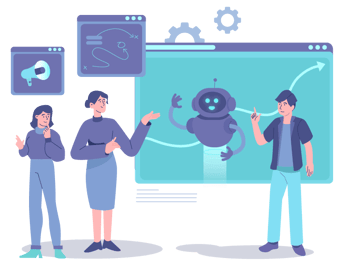Artificial intelligence (AI) is probably already a trusted tool in your data-driven marketing department. In surveys conducted by Salesforce in 2019, 61% of marketers used some form of AI, and 27% planned to implement it. Today, the use of AI in business is omnipresent.
The enthusiasm for using AI isn't just because it's a "shiny new toy;" it's because AI offers "smarter inbound," increasing conversion rates through predictive analytics, personalization, and much more.

But what happens once all those leads are generated by the marketing team? Does the sales team use the same sophisticated technology? Probably not—Gartner's data suggests that only about 30% of all B2B companies will implement AI for at least one of their primary sales functions next year. That figure means that most B2B organizations will miss rich opportunities to revolutionize their business development. Here's a look at three ways your sales and business development team can benefit through "smarter outbound."
1. Increased Capacity for Closing Sales
Consider how much your team spends on non-value-adding tasks like entering information into your CRM. Even the back-and-forth emailing sometimes required to schedule a meeting takes time that your team could use for closing deals. But your team could have an AI-powered "assistant" handle the calendar, while another robot could automatically enter client interactions into the CRM in real time. These are relatively simple functions that could be almost entirely automated, giving your team more time to engage with leads and customers.
Meanwhile, more sophisticated outbound activities can also be automated, such as initial outreach through email or various social networks. AI-powered tools now even provide the personalization that once required a human touch. This frees your team to engage more meaningfully with prospects who respond to that first AI-initiated contact.
Tip: Use AI to automate non-value-adding tasks
Here are some examples:
-
-
Entering information into CRM: AI can automatically enter information into CRM systems, such as contact information, notes from conversations, and sales opportunities. This frees sales reps to focus on more critical tasks, such as building relationships with leads and closing deals.
-
Scheduling meetings: AI can automatically schedule meetings between sales reps and leads. This can save sales reps time and effort and help ensure that meetings are scheduled conveniently for both parties.
-
Sending emails: AI can automatically send emails to leads and customers. This can help to keep leads engaged and informed, and it can also help to build relationships with customers.
By automating these, business development reps and sales executives free up their time to focus on more valuable tasks, such as closing deals. Here are some additional tips for using AI to increase time for closing sales:
-
Use AI to personalize your outreach: Increase engagement and improve the chances of closing a deal.
-
Use AI to identify the best leads: Focus your sales efforts on the most likely converting leads.
-
Use AI to track your results: Improve your sales process and increase your chances of closing deals.
2. Improved Engagement with Prospects and Clients
Today's customers have come to expect highly personalized interactions. A recent Salesforce survey revealed that up to 65% of B2B buyers would likely change brands if they felt they were not getting personalized attention. And we aren't just talking about putting a prospect's name at the top of a bulk email. We're discussing delivering relevant, engaging content that fits that person's industry, expressed interests, and business challenges. This might sound daunting, especially if your business development team is swamped with leads.
Enter AI algorithms. First, they can offer prescriptive insight into which leads are more promising and why. No longer will your sales team have to rely on incomplete information or their gut feelings about a prospect. Nor will they spend time on leads who are unlikely to make a purchase (nurturing these leads can be automated—more about that in an upcoming post). Furthermore, these algorithms can provide personalized recommendations for communicating with these prospects and customers.
Tip: Use AI to personalize your outreach.
Here are some examples of how AI can be used to personalize your outreach:
-
-
Use AI to segment your leads: Segment your leads based on their industry, expressed interests, and business challenges, allowing you to tailor your outreach to each segment, which can increase engagement and improve the chances of closing a deal.
-
Use AI to generate personalized content: Generate personalized content for your leads and customers, tailored to their specific interests and needs, which can help to keep them engaged and informed.
Using AI to personalize your outreach can increase engagement with prospects and customers. This can lead to increased sales and improved profitability. Here are some additional tips for using AI to improve engagement with prospects and clients:
-
Use AI to identify the best time to reach out: Identify the best time to reach out to prospects and customers and ensure that your outreach is timely and relevant.
-
Use AI to identify the best channels to use: Identify the best channels to reach out to prospects and customers and ensure that your outreach is seen and heard.
3. Increased Visibility for Performance Management and Sales Forecasting
Sales managers often struggle to meaningfully monitor and evaluate the progress of their business development teams--and according to CIO Insight, about 85% of organizations struggle to forecast sales accurately. These challenges are essentially visibility issues because they boil down to having inadequate access to the right data: performance management requires real-time data on pending and closed sales. In contrast, accurate sales forecasts are often based on dozens of additional data points from various internal and external sources.
Using data from your CRM and other sources, AI algorithms can build a real-time dashboard that offers managers valuable insight into the team's performance, including deals close to the finish line and those that might be faltering. AI can then help you get more accurate sales forecasts by pairing that real-time data with historical sales data and current industry trends—which can then be coupled with predictive analytics to address future conditions.
Tip: Use AI to build real-time dashboards and reports.
-
-
Use AI to collect, analyze, and report on data: Collect data from various sources, such as CRM systems, social media, and customer surveys and build real-time dashboards to provide team members and managers with valuable insights into the team's performance.
Tips for Introducing AI to Your Business Development Processes
-
Present AI very simply as a valuable tool for your team. When people think about artificial intelligence, they may picture a physical robot strolling up to the company water cooler. While that would be pretty cool, the reality is that your organization's AI is more likely to be an algorithm that runs in the background of your daily business operations—hardly noticeable, but also a potent tool that can help your organization answer essential questions. Presenting AI in this context can help assuage fears that robots will replace employees or answer objections that AI is just the "next new thing" people will be forced to adopt.
-
Identify valuable data sets across the organization. The marketing team likely has a wealth of data to offer, from website analytics to the results of individual campaigns. Customer service may also bring valuable insights. The power of AI emerges when you combine sales data, such as historical purchasing information, with relevant data from other domains.
-
Remember that technology supports people. The most effective way to integrate AI is as a complement to human expertise. Forrester found that companies that blended AI with human insights saw a 69% increase in sales team satisfaction, 68% improved operational efficiency, and 66% improvement in sales representative productivity.
In early 2023, HubSpot introduced ChatSpot and Content Assistant (now in HubSpot Content Hub) to create efficiencies for marketing, sales, and customer service professionals. In 2024, the introduction of AI agents marked a massive step forward in the evolution of AI.
-
Content Assistant: Content assistant helps marketing and sales teams ideate, create, and share quality content in minutes if not seconds. Among many options, content assistant can:
-
Suggest blog titles related to a product or service, then generate a complete blog post outline for that title;
-
Write content in a flash for blog posts, landing pages, website pages, sales and marketing emails, and knowledge base articles;
-
Streamline content marketing workflows into one place, saving teams time and energy.
Ready to boost your business development with AI? Aspiration Marketing consultants can help. Contact us today.










Leave a Comment